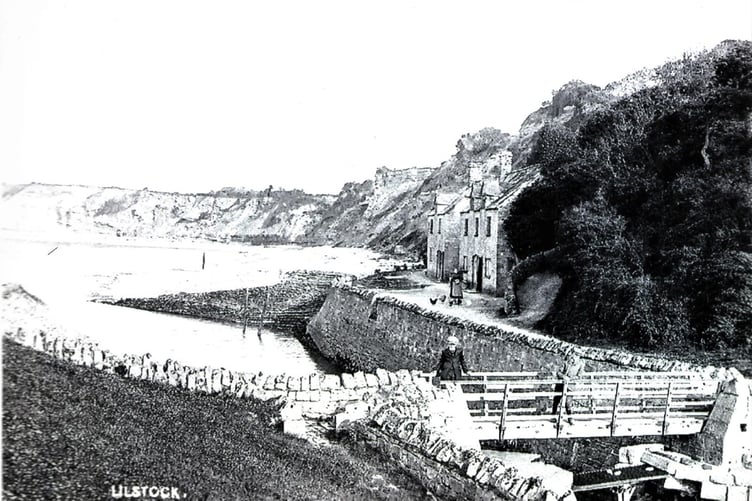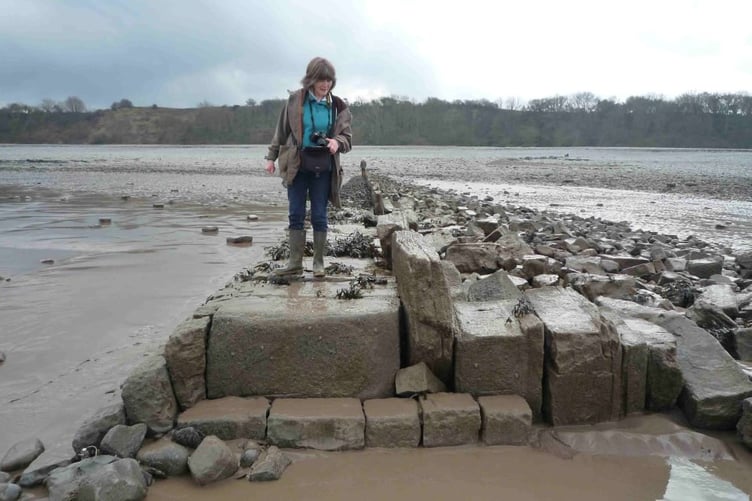LITTLE more than a century ago it was a busy West Somerset harbour, accommodating up to five coasters and welcoming hundreds of tourists arriving in pleasure-steamers from all points of the Bristol Channel.
But all that would dramatically change when four days after Christmas 1900, the port of Lilstock, in a sheltered cove two miles west of Hinkley Point, literally vanished overnight. A Force 12 storm which laid waste Watchet harbour, roared up the channel to roll thousands of tons of shingle into Lilstock and smother it to death.
The place was marooned behind a 40 foot wall across the entrance and no ship ever entered or left again.
Today, all that remains of a busy maritime community is a grassy dip, the sketchy outlines of stone walls and the remnants of a lime-kiln. Only the remains of quays and walkways, a slipway and an old dry dock emerge at low tide to provide some sort of sombre memorial.
It’s hard to believe that there was once a massive quay, warehouses, cottages for dock-workers and a pub called the Limpet Shell.
Lilstock had its own customs officer and coastguards, and the local gentry built holiday pavilions in adjoining woods. Over the years more than £100,000 was spent with the intention of making the place into a major Bristol Channel trading port.
This was to be the prelude to an even grander scheme which would have made Lilstock the northern entrance of a giant 60-lock 44-mile canal linking the English and Bristol Channels and allowing ships to avoid sailing around Land’s End. Over £2 million was raised for the project - worth over £200 million today.
The place continues to have a nearly-secret history but it is known that there was a port there in Saxon times. Around 1820, Sir John Acland, whose ancestral home of Fairfield was just across the fields, realised the harbour had commercial potential and built a boathouse, followed by a small harbour alongside a stream which ran parallel to the beach.
Coal was brought from south Wales for domestic use on the Acland estate and to fire lime kilns on the nearby cliff which provided limewash, mortar and fertiliser. Pit-props were exported to Welsh collieries. It was after Sir John died in 1831 that his son, Peregrine, seriously developed the harbour as a commercial port, building a 100ft pier from the north side of the harbour wall.
A long dock was excavated behind the wall and the stream was diverted to maintain the water-level and with sluices and lock gates, to create a substantial harbour. Trade grew steadily and by the 1840s warranted the appointment of a customs officer and two coastguards.
It became a popular place to visit: tourists would stroll along the quay and patronise a café and butler’s pantry at the end of the pier as paddle-steamers arrived with day-trippers from Burnham, Cardiff and as far away as Bristol.
Commercial and tourist activity peaked during the second half of the 19th century when the hamlet’s population reached 94. Carriages brought visitors for picnics and evening soirees under awnings along the quay. There were concerts and theatrical performances patronised by minor royalty.
It was said that Sir Peregrine spent nearly £100,000 creating Listock harbour but wasn’t just trade he had in mind. When his wife, Fanny and their three children contracted tuberculosis, only his eldest daughter, Isabella survived. She was advised to live near the sea and her father built her an elegant wooden pavilion overlooking the harbour with its own road leading to the beach.
The open-air life obviously suited Isabella Acland. She recovered completely, married a local baronet, Sir Alexander Hood, and had nine children. Sir Peregrine built a primary school in Stogursey as an offering of thanks for his daughter’s return to good health, recording the event in an inscription over the door.

Lilstock’s grandiose hopes of dominating the Bristol Channel coasting trade were first raised in 1820 when the doyen of canal engineers, Thomas Telford, was commissioned to create a canal from Seaton on the south coast to Bridgwater Bay.
Fresh from his triumphant completion of Scotland’s Caledonian Canal, Telford was faced with one of the biggest engineering projects of the century and one which would have cut Somerset in two.
The canal would be 15 feet deep and 90 feet wide to accommodate ships of 200 tons. There would be 60 locks and the initial cost, including two harbours, estimated at just over £2 million, bringing in a yearly revenue in canal dues of at least £210,000.
Telford was confronted by unprecedented technical challenges and eventually called it a day, but several other attempts were made to revive the project, the last one in 1922, but nothing came of them.
Sir Peregrine continued to develop LiIstock harbour but his mind was increasingly on other things. In 1856 he chaired the first meeting to discuss a plan to build a West Somerset Railway from Taunton to Watchet, which finally became a reality in 1859.
The minutes of that first meeting, at Williton’s Egremont Hotel, record that among those present was one Isambard Kingdom Brunel, “who had much to say.”
Sir Peregrine died in 1871 and the estate is now inherited by Elizabeth Lady Gass, a former Lord Lieutenant of Somerset.
After the 1900 storm the barrier of shingle prevented the stream reaching the sea and after constant flooding, the remaining residents moved out.
The last building - the harbour master’s house - was demolished in the 1950s. There were several attempts to dredge out the harbour entrance but the decline in small coastal shipping made it uneconomic and Lilstock was left to the wind and the waves.
In a recent book on the Somerset coast, a writer observed: “Today Lilstock is not worth finding. At the end of everything there is nothing there.” Maybe, but, as we now know, that was once not the case at all.





Comments
This article has no comments yet. Be the first to leave a comment.